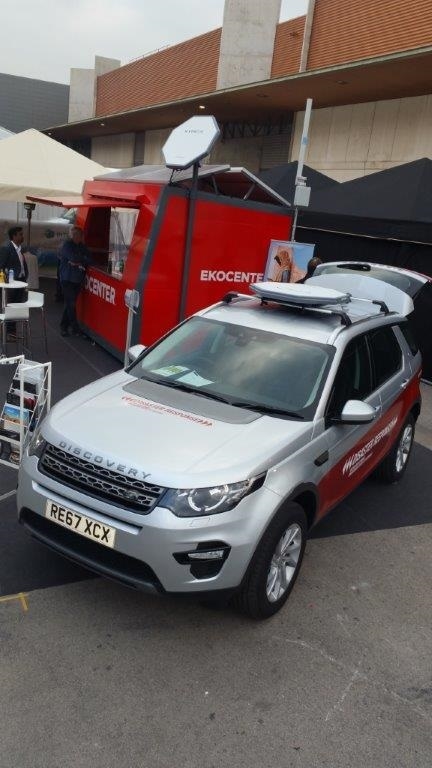Last week marked Kymeta’s first year renting meeting space at Mobile World Congress, and it had a big message to tell. It’s broken ranks with the satellite industry and jumped headfirst into supporting terrestrial wireless, with a caveat: The industry needs to work out a way to accommodate both these often adversarial technologies in 5G.
It's a bold move given that Kymeta relies on satellite technology to deliver internet access. A year ago, the Redmond, Washington-based company and satellite operator Intelsat announced they had joined forces to offer a satellite service called KĀLO, designed to offer a simple way to buy and sell connectivity to customers and sectors that are unreached or underserved by terrestrial networks.
The satellite industry has been fighting to keep its spectrum, notably in the 3.7-4.2 GHz band, which wireless operators are eyeing for 5G services. On the table is a proposal endorsed by Intelsat, SES and Intel that seeks to protect the established satellite services in the 3.7-4.2 GHz C-band downlink spectrum while opening a specified portion of that spectrum for terrestrial mobile use.
Kymeta, whose investors have included Microsoft founder Bill Gates, is positioning itself as a connectivity company as opposed to a satellite company. “Unfortunately the satellite industry has been positioning itself in opposition to the terrestrial world and fighting the spectrum reallocation ideas,” said Tom Freeman, senior vice president of Land Mobile at Kymeta. “And Kymeta has broken with that and said we’re about connectivity to the automobile and connectivity for communication period, and frankly, we don’t care. At the end of the day, we’re not in the satellite business, we’re in the communication business and as such, we need to be able to provide communications to trains and planes and automobiles and what that means is there needs to be a graceful switchover between the two.”
When someone is driving along in a rural area, for instance, and they’re using satellite to do a Skype call, it needs to seamlessly switch over to the LTE or 5G when the car goes in a tunnel or enters an urban area where the satellite is blocked. Turns out, “people don’t care where their connectivity comes from,” Freeman said.
“It hasn’t made us particularly popular in the satellite world,” he acknowledged. But he’s of the mind that the satellite industry has not used its spectrum well. “It’s underutilized,” he said. “Our friends in cellular have done a great job of reusing a limited resource. Satellite, not so much. Satellite’s still back in a … 1G, 2G world, in which the number of users you can get off one beam is pretty primitive and all that’s got to change.”

Kymeta brought one of its cars equipped with its terminal to Mobile World Congress, where it demonstrated how it enables always-connectivity through hybrid satellite and cellular network solutions, with the satellite capacity provided by Intelsat. Kymeta’s real intellectual property resides in the glass portion of the terminal, which is highly prized and protected.
“The big difference between the Kymeta product and any other flat panel solution that’s ever been is that we’re using metamaterials as kind of the core of our technology,” explained Lisa Dreher, director of Marketing at Kymeta. The big difference between metamaterial and the phased array antennas that so many other companies use has a lot of do with cost: phased array requires a lot more elements, amplifiers, a cooling solution and high power consumption.
Kymetta’s mTenna uses software-driven, tunable metamaterial elements to holographically create a beam that can be electronically steered to follow a satellite, meaning it can stay connected even while moving. The enterprise and commercial applications are centered on providing steady Wi-Fi networks; it was used by police in Greenville, South Carolina, during the eclipse last year, for example.
RELATED: Kymeta drives away from eclipse with renewed focus
Kymeta received blanket authorization from the FCC last year for commercial distribution of 11,000 of its KyWay terminals in the United States. It expects to sell 3,500 of them this year for things like buses, trains, yachts and other kinds of maritime. It’s also working with partners like Toyota to get its terminals small and light enough to fit into the roof of mass market cars.
The big reason for attending MWC this year was to meet with mobile operators the world over, which it did, without naming names. Freeman noted that the 3GPP is on board with satellites being part of 5G as well.
Kymeta would seem well positioned to make inroads with carriers, having hired Chief Commercial Officer Neville Meijers, who previously was in charge of the Private LTE/5G Networks and industrial internet of things business at Qualcomm. “This has been an extraordinarily successful show,” Freeman said.
Time will tell soon enough whether its next show—the satellite industry's Satellite 2018 show—is as successful. Kymeta plans to be in Washington, D.C., for the event, which runs March 12-15.

